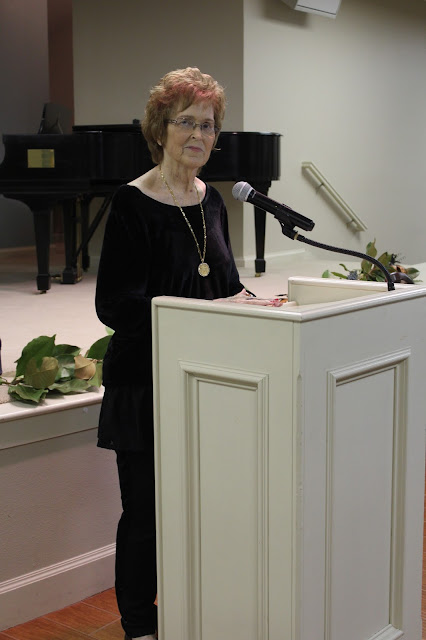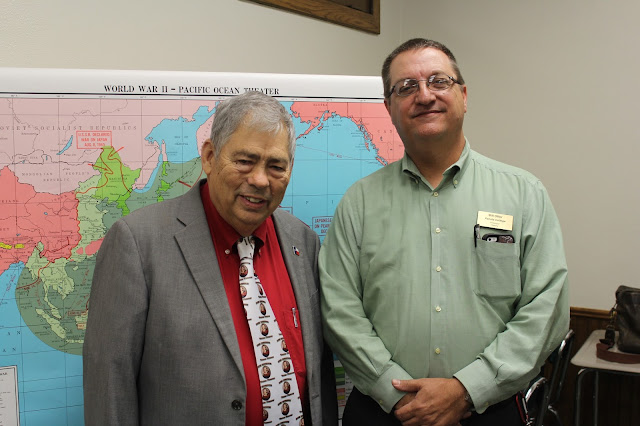On Monday through
Thursday, November 6, 7, 8, 9, I had the pleasure of presenting four State
Historian programs in four days at four different locations. It proved to be a
delightful experience, filled with history-centered events and kindred spirits
and old friends.
I was born and raised in
Corsicana and I graduated from CHS and Navarro College. My paternal
grandparents and great-grandparents were rural pioneers of Navarro County
during the 1880s and my father was born and raised on a Navarro County cotton
farm. So I grew up with Navarro County history and legends, and I am a longtime
member of the Navarro County Historical Society. I have spoken at Society
events through the years, but I was especially pleased when I was invited to address
the Society's annual banquet. My sister and brother, Judy O'Neal Smith of
Lampasas and Mike O'Neal of Carrollton, both decided to attend, because they
too were born and raised in Corsicana and graduated from local schools. We
arrived on Monday afternoon and spent three hours together, we were seated at
the same table at the banquet, and each of us saw old friends and schoolmates.
 |
| Members of the Navarro County Historical Society |
 |
| Introduction by Carolyn Taylor |
 |
Holding an antique CHS Tiger jersey, one that I wore 60 years ago
during the 1957 season. |
My topic was how
Corsicana and Navarro County have been deeply involved in the mainstream of
Texas history. Navarro County was organized in 1846, the year that Texas became
the 28th state. Cotton was king in Texas at that time, and Navarro County,
situated in the rich Blackland Prairie of Texas, was an important part of the
Lone Star State's cotton economy for more than a century. When the Frontier
Battalion of Texas Rangers was organized in 1874, the commander was Major John
B. Jones, a Confederate veteran - and a Navarro County horse rancher. In 1895
the first oil field and oil refinery west of the Mississippi River were developed
in Corsicana. The Corsicana Oilers, 1904 champions of the Texas League, set
records that still stand in professional baseball. The Corsicana High School,
Jackson High for colored students, and Navarro College football teams won state
and national championships, and longtime CHS coach Johnnie Pierce became the
Father of the Texas High School Coaches Association, the best such organization
in the nation. Governor Buford Jester was a native of Corsicana, and so was
Country Music legend Lefty Frizzell. "Big Tex," an icon of the Texas
State Fair, began as "Big Santa" in Kerens, east of Corsicana. There
was much else, and it was fun for me to put together this program for the
Navarro County Historical Society.
 |
| With my brother and sister, Mike O'Neal and Judy O'Neal Smith |
I drove home late that
night, because on Tuesday morning I was scheduled to deliver a presentation
about Sam Houston on the Panola College campus. Bill Offer, a jovial and highly
energetic history instructor, had asked me to visit his Tuesday-Thursday Texas
history class, and to take the entire hour and fifteen minute period talking
about "Old Sam Jacinto." The class was held in the room where I had
taught for many years, and I had a terrific time interacting with the young men
and women of his Texas history class.
 |
| Bill with Bill Offer, Panola College History Instructor |
 |
| With the Panola College Texas History class |
 |
| Demonstrating the San Jacinto Battle Flag |
That afternoon I drove
toward Austin, where I had been asked to speak at a gathering of Texas history
teachers at the Bob Bullock Museum of Texas History. The two-day event was
organized by the Texas State Historical Association as part of the "Experiencing
Texas" Workshop Series, and 60 teachers attended. Charles Nugent,
TSHA Adult Program Organizer, lined up programs and speakers for two days on
the time period 1836-1900. He asked me to speak after lunch on Wednesday
on "The Regulator-Moderator War of Old East Texas."
 |
| The Bob Bullock Texas State History Museum |
 |
Four key TSHA officials: Esther Rivera, MK Marshall, Charles Nugent,
Steve Cure |

The Regulator-Moderator
War was the first blood feud of Texas, where more blood feuds were fought than
in any other state or territory. The Regulator-Moderator War was part of a
tradition of Regulators vs. Moderators that dated back to the troubled period
before the American Revolution, and the four-year backwoods clash in the
Republic of Texas resulted in the death of 31 participants.
I drove home from Austin
after the meeting, because the next morning at 8:30 I was scheduled to speak in
Center at a day-long Conference of the Shelby County Junior Chamber of
Commerce. The JCC is comprised of students from every secondary school in
Shelby County, and almost 200 young ladies and gentlemen crowded into the Civic
Center in Center. I was invited to deliver the opening address by Deborah
Chadwick, Interim Director of the Shelby County Chamber of Commerce. My
topic was the same as the day before, "The Regulator War of Old East
Texas." Of course, the subject was especially pertinent because so much of
the conflict was fought in Shelby County that it was often called "The
Shelby War." I tried to emphasize to the young students that their home
area was the site of one of the most important events in the history of early
Texas. The program was well-received, and later in the day the keynote address
was presented by State Representative Chris Paddie, who administered the oath
of office to me for my second term as State Historian. A special pleasure for
me was a gracious introduction by a former student of mine, Allison Sanford.
 |
| John D. Windham Civic Center in Center |
 |
Introduction by Allison Sanford, Conference Chair
and a former student of mine |
 |
| Almost 200 members of the Shelby County JCC gathered in the Civic Center |
 |
| Everyone stood for the Pledge of Allegiance |
 |
| With Deborah Chadwick |





















































